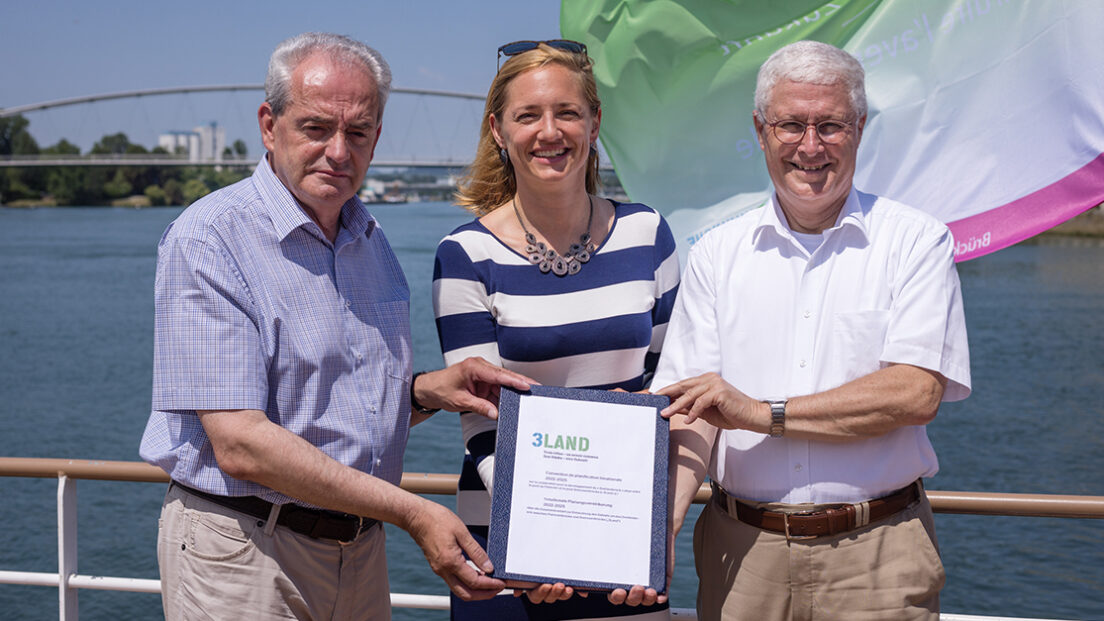Ten years of cross-border urban development at the border triangle of Basel

With the signing of another trinational planning agreement today, the neighboring cities of Basel (CH), Weil am Rhein (D) and Huningue (F) are reaffirming their cooperation and the development of a cross-border district at the border triangle. The planning of a new Rhine bridge between Huningue and Basel reaches the next milestone. The political leaders confirm this common goal.
The “3Land”, the area around the border triangle, which for decades was characterized by industrial and port facilities, is in transition and will change in the coming years. There is space for something new. Large, closed and mono-functional areas are to be opened up and reused. New lines for public transport, accessible and continuous banks of the Rhine and networked green and open spaces create a cross-border district.
The cooperation between the neighboring cities of Basel, Weil am Rhein and Huningue, which has lasted for more than ten years, is already showing visible results: A continuous Rhine bank path was created between Huningue and Basel, which is equally popular as a commuter route and as a promenade in leisure time. With the expansion of the Rheinpark in Weil am Rhein and the redesigned shore areas in Huningue, new open spaces were created directly on the water on both sides of the three-country bridge. They offer a wide range of games, sports and recreation and will be expanded in future construction stages. This is how the 3Land idea creates a tangible benefit for the population.
On behalf of the eight partners involved, the Basel government councilor Esther Keller, the mayor of Huningue and president of Saint-Louis Agglomération, Jean-Marc Deichtmann, and the mayor of Weil am Rhein, Wolfgang Dietz, signed a trinational planning agreement today at the border triangle the next steps and a joint budget until the end of 2025. The main topics are mobility, open space and nature conservation, spatial planning and urban development.
A new Rhine bridge is central to growing together and mobility in 3Land. Designed for tram, foot and bicycle traffic, it connects the banks of the Rhine between Huningue and Basel at the height of the Wiese estuary. A recent cost-benefit analysis confirms that the Rhine bridge will bring major economic benefits to all three countries involved. It enables a trinational quarter by connecting countries, bringing people together and creating a high quality of life through sustainable transport connections. The project partners have therefore decided to continue the ambitious project and to create the planning, legal and financial basis for the project in the next steps. The course for this is set in the joint planning agreement.
The new 3Land tour offers an interesting insight for cyclists and pedestrians. The 13-kilometer route leads through the project area and makes the stories and special features of the quarters come alive at ten stations. Informative texts, images and videos are available at the individual stations and on the 3Land project website. The GPS data can be loaded onto a smartphone using the well-known “Outdooractive” app.
For the continuation of planning for trinational urban development in 3Land, the government council is requesting that the Great Council spend a total of CHF 1,106,000. The 3Land planning agreement signed today by the head of the construction and transport department is subject to the approval of the expenditure by the Grand Council.
The “Coordination Cell 3Land” is funded by the European Regional Development Fund (ERDF) as part of the Interreg V Upper Rhine program of the European Union, the canton of Basel-Stadt and the Swiss Confederation, as well as the city of Weil am Rhein, the district of Lörrach, the city of Huningue , Saint-Louis Agglomération and the Collectivité européenne d’Alsace. The city of Saint-Louis is an associated partner. The project sponsor is the Trinational Eurodistrict Basel.